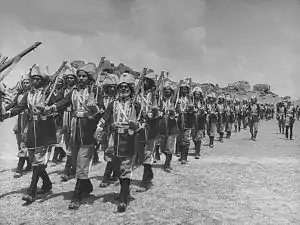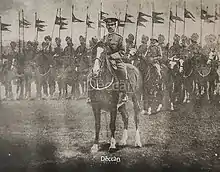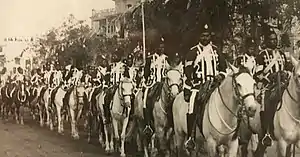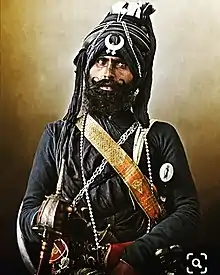Hyderabad State Forces
The Hyderabad State Forces were the armed forces of the princely state of Hyderabad. People from both India and abroad were recruited into the Forces. Among these groups were Arab nationals like Chaush and African nationals like Siddis who now stay in Barkas and A. C. Guards areas of Hyderabad respectively.[1] The Hyderabad cavalry was chiefly composed of Muslim castes such as Mughals, Pathans, Syeds, Sheikhs and Balochs. They were principally recruited from the Deccan, but Delhi, Lucknow, Shahjahanpur, Sindh and Balochistan also supplied recruits to bolster ranks. These non-indigenous soldiers were known as the "Rohollas". The Hindus made a very small portion of the cavalry.[2] The Nizam of Hyderabad also had about 1200 Sikh guards.[3] Other battalions within the army were referred to with the suffix "-walas". Some troops were also supplied by the Europeans for the security of the Nizam.[4]
| Hyderabad State Forces | |
|---|---|
| Sarf-e-khas | |
 Well-armed Lashkars of the Hyderabad army | |
| Founded | 1724 |
| Current form | Some assimilation into the Indian army |
| Disbanded | 1948 |
| Headquarters | Barkas, Hyderabad |
| Leadership | |
| Major general | Syed Ahmed El Edroos (1948) |
Commanding Divisions


.jpg.webp)

Three different corps were commanded by three different independent commanders. The Nizam, the Diwan, and an important officer in the Nizam's government, Shangal Umara or "Amin Kabir", each maintained their own separate divisions.[4]
During the time of Operation Polo, the Hyderabad State Forces consisted of six infantry battalions, two Cavalry regiments, and 1,500 armed irregulars. The army had two light armored regiments and one field battery.[5] In total, the Nizam's army numbered 24,000 men, of whom some 6,000 were fully trained and equipped. Some of the units surrendered on the first two days of the Operation. Four Hyderabadi infantry companies and three cavalry squadrons were later absorbed into the Maratha Light Infantry, Madras Regiment, Poona Horse and Deccan Horse of the Indian Army, respectively.[6]
History
British Rule
In 1767-1768, Nizam ʿĀlī accepted British Suzerainty over Hyderabad State through the Treaty of Masulipatam. From 1778 onwards, a British resident and subsidiary force were installed in his dominions.[7] Nizam ʿĀlī Khan, Asaf Jah 2 was pushed to enter into an agreement that placed his country under British protection in 1798.
Nizam ʿĀlī Khan and his soldiers fought for the British in the Second (1803–05) and Third (1817–19) Maratha Wars, and Nizam Nāṣir al-Dawlah and Hyderabad's military contingent remained loyal to the British during the Sepoy Mutiny (1857–58).
Operation Polo
In September 1948, the Indian Army invaded Hyderabad State. The battle between the Nizam's army and the Indian Army lasted for five days, and culminated with a decisive Indian victory. On Day 5 of this operation - 17 September 1948, the 7th Nizam announced a ceasefire, ending armed action. As a result, Hyderabad was integrated into the Indian Union[8][9][10]
External links
References
- Yimene, Ababu Minda (2004). An African Indian Community in Hyderabad: Siddi Identity, Its Maintenance and Change. ISBN 9783865372062.
- Haraprasad Chattopadhyaya (1957). The Sepoy Mutiny, 1857: A Social Study and Analysis.
- "Maharaja Ranjit Singh's". Archived from the original on 17 April 2015. Retrieved 25 February 2019.
- Rao, P. Raghunatha. ఆధునిక ఆంధ్ర దేశ చరిత్ర (The History of Modern Andhra Pradesh).
- Khanna, K K (7 March 2015). Art of generalship. p. 161. ISBN 978-9382652922.
- Lucien D. Benichou (1 January 2000). From Autocracy to Integration: Political Developments in Hyderabad State, 1938–1948. Orient Blackswan. ISBN 978-81-250-1847-6.
- "Hyderabad". Britannica. Encyclopædia Britannica. Retrieved 7 October 2016.
- "Hyderabad 1948: India's hidden massacre". BBC News. 24 September 2013.
- "27,000 Massacred, in the name of 'Liberation': Hyderabad 1948". 17 September 2015.
- Ramachandran, D.P. Empire's First Soldiers. Lancer. pp. 178–179.